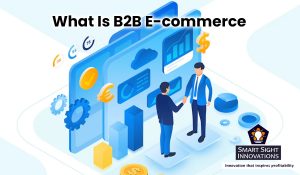 What Is E-commerce?
What Is E-commerce?
E-commerce is the process of carrying out transactions over the internet. It involves the buying and selling of products and services online. E-commerce, also called electronic commerce or online commerce, operates in several business segments and can be carried out using computers, tablets, smartphones and other smart devices. They provide immediate access to almost any commodity or service, making it a highly competitive market.
Custom e-commerce development services have benefitted many businesses by expanding their presence in the market and providing affordable and effective sales channels. Providing goods and services online requires extensive research. Selling goods, understanding market trends, understanding your customer base, knowing your competitors, estimated cost to the company, etc., all need enormous exploration and groundwork. An e-commerce company can either sell to customers (B2C) or to businesses (B2B). Customers who sell to businesses (C2B) or other customers (C2C) can also operate in e-commerce.
What Is B2B E-commerce?
B2B, or business to business, is a trade carried out between two companies, such as that between a manufacturer and a wholesaler or a trade between a wholesaler and a retailer. In the production process, usually, B2B takes place where one business purchases raw materials from the other and uses them for manufacturing products. Buyers make purchases for their businesses through an internet portal and the finished product is then sold to individuals through other trading channels.
Businesses can significantly change how they conduct B2B sales and purchases by bringing the transaction process online. Planning is an essential part of making B2B transactions successful. These transactions depend on the account management staff of a business to develop client connections. For successful transactions to exist, these relationships must be established through professional meetings prior to sales. B2B businesses are ideal for operating in the online sector as they can generate more revenue. Some of the best examples of B2B e-commerce are:
- Amazon
- Alibaba
- IndiaMart
- Quill
- Walmart
- Ferguson
- V-Belt Guys
- eJuices
- General Electric
Types of B2B E-commerce
Many B2B business models are used in various industries, such as payroll and tax, research and development, website design, SEO services, call centers, human resources and recruitment, marketing, advertising, etc.
Company websites let potential buyers find out more about their products and services and make contact. Online portals also help business buyers analyze their inventory trends, improve the purchase process, link inventory management software with their suppliers and ensure that their inventory never runs low due to negligence. Some types of B2B models are:
-
Customer centric model
In this model, customers are given high priority and equally valued even after a sale. The relations with the customers are maintained to do profitable business again in the future. Amazon and Flipkart are the best examples of this model.
-
Buyer centric model
In this model, the buyer sets a portal for sellers and providers to bid and quote for the purchases. The buyer then takes a call and chooses the business that best suits their needs. An example of this model is Walmart.
-
Intermediary centric model
This model provides a common forum for dealings between sellers and buyers by the intermediaries. The parties involved, in return, pay the intermediary a reasonable share as a commission. Ebay and OLX are examples of intermediary centric models.
-
Managed B2B model
In this model, a business outsources all of its B2B process requirements. This allows the companies to cut down on additional costs and inefficiencies.
Stages of a B2B Business
Every B2B business journey is unique. But there are a few phases that every B2B company undergoes as they expand. The stages are as follows:
-
Startup
In the startup stage you pick an idea, make it a reality and get the initial sales. This is also the feedback stage and you can modify and experiment different segments of your business to suit the market. Brand awareness is also created in this stage.
-
Growth
In this stage the sales increase and your business is attracting new customers. The growth stage allows you to explore new partnerships and offers, hire employees at important positions, experiment with market strategies and continue to build business relationships.
-
Expansion
This stage involves broadening your distribution network, creating a long-term customer relation policy and maintaining growth.
-
Maturity
The revenues are dependable at this stage and you can trust the projections to maintain the growth and profits. You can look to expand and try new markets.
Advantages of B2B E-commerce
Some of the advantages of B2B businesses are:
- Better business predictability
- Revenue budgets are accurately and easily planned
- They have greater stability
- Higher customer loyalty
- Mutual understanding between the buyer and the seller regarding service, quality, value, dependability, etc.
- Shorter selling cycle
- Help in lowering the overall costs
- Factual data is used for increasing efficiency in the process
- Buyers get to choose their products and can avail cheaper rates
Disadvantages of B2B E-commerce
Some disadvantages of B2B e-commerce are:
- Though B2B companies can target businesses across all industries, the business market is limited, making it risky for small and midsize firms.
- B2B businesses often need help to persuade customers to make recurring purchases.
- Customers may want to examine, feel and use goods before purchasing them in bulk. The e-commerce platform unfortunately does not allow this.
- Since the B2B market is small, it is very competitive.
- B2B buyers purchase in bulk, hence they negotiate for lowering the price, ask for discounts and offers and demand extra services.
- The supply chain can get complicated especially when multiple partners are involved. As every partner needs access to the same information, it becomes confusing, resulting in miscommunication and slows down the process.











